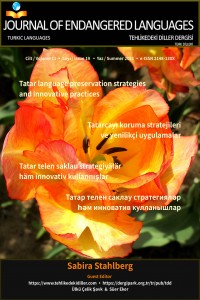Visual Images as Mnemonic Devices in the Context of Language Revitalisation: Some Notes with Sample illustrations
Abstract
This article gives an example of how visual data can be used as an educational aid in the
context of language revitalisation. Here the language for presenting the use of visual data in
interactive learning is Noghay, a small Kipchak Turkic language spoken in the Northern Caucasus.
Noghay is relatively close to Mishar Tatar, a variant of Tatar spoken in the Volga region and in the
Tatar diaspora of the northern Baltic Sea region.
Today the use of Noghay is rapidly decreasing, as a growing number of children and young people
prefer to speak Russian, which is the socially dominant language. The transmission of the language
from one generation to another is also endangered by migration to cities and resulting bilingual
situations, where children are not forced to actively speak Noghay. Elderly persons however still
prefer Noghay to Russian, and children could be motivated by contact with the older generation to
activate their knowledge of the family language.
The purpose of using visual data in reawakening a language is to trigger linguistic memories of the
community’s heritage language in young bilingual children, which they do not use actively or in their
everyday life. We assume that visual data, especially photos depicting realistic situations from their
community life, are well suited to stimulate emotional attention and elicit memories of situations in
which the heritage language is preferably used. Our approach combines materials gathered during
field research and from language and cultural documentation with methods mainly drawn from
pedagogy and linguistics.
References
- Austin, Peter & Sallabank, Julia (2018). “Language documentation and language revitalization: Some methodological considerations”. Hinton, Leanne; Huss, Leena; Roche, Gerald (eds), The Routledge Handbook of Language Revitalization. Abingdon: Routledge. p. 207–215.
- Brown, H. D. (2019). Language assessment: principles and classroom practices. White Plains, NY: Pearson Education (third edition).
- Himmelmann, N. P. (2006). Language documentation: What is it and what is it good for? Gippert, J., Himmelmann, N. P., & Mosel, U. (eds.). Essentials of Language Documentation. Berlin & New York: Mouton de Gruyter. p. 1–30.
- Karakoç, Birsel (forthcoming). Noghay, Johanson, Lars & Csató, Éva Á. (eds.). The Turkic languages. London & New York: Routledge. (Second revised edition).
- Nathan, David and Fang, Meili (2009). Language documentation and pedagogy for endangered languages: a mutual revitalisation, Peter K. Austin (ed.). Language Documentation and Description, volume 6. London: SOAS. p. 132–160.
- Penfield, Susan D. & Tucker, Benjamin V. (2011). From documenting to revitalizing an endangered language: where do applied linguists fit? Language and Education 25:4. p. 291–305.
- Sapién, Racquel-María and Hirata-Edds, Tracy (2019). Using existing documentation for teaching and learning endangered languages. Language and Education 33:6. p. 560–576.
- Stahlberg, Sabira (2020). Multicoloured language. Helsingfors/Helsinki: Bokpil.
Görsel Malzemenin Dilin Yeniden Canlandırılması Bağlamında Anımsatıcı Olarak Kullanılması: Notlar ve Örnekler
Abstract
Bu makale, yok olma tehlikesiyle karşı karşıya olan dillerin yeniden canlandırılması çabaları
çerçevesinde görsel malzemenin eğitim amaçlı ne şekilde kullanılabileceği üzerine bir örnek
sunmaktadır. Etkileşimli öğrenmede görsellerin rolünü ortaya koyarken Rusya’nın Kuzey Kafkasya
bölgesinde konuşulan ve konuşur sayısı yönünden bakıldığında küçük ölçekli Türk dillerinden biri
sayılan Nogayca örneğinden hareket edilmiştir. Nogayca, Volga ve Kuzey Baltık Denizi bölgelerinde
konuşulan Mişer Tatarcasına yakın bir dildir.
Günümüzde, çocukların ve gençlerin, çoğunlukla, toplumsal kullanım açısından baskın dil konumunda
olan Rusçayı tercih etmeleri sonucu Nogaycanın kullanım oranı hızlı bir şekilde azalmaktadır. Ayrıca
yine ekonomik kaygılarla büyük şehirlere doğru yaşanan göçlerle birlikte çocukların Nogaycayı aktif
bir şekilde kullanacakları toplumsal alanların gittikçe daralması dilin nesilden nesile aktarımını
zorlaştırmaktadır. Diğer yandan ise yetişkinlerin önemli bir kısmının ve yaşlı neslin neredeyse
tamamının Nogaycayı tercih ediyor olması çocukların bizzat kullanmasalar da bir ölçüde aile içi
iletişimi sağlayan bu dili en azından anlamalarında hala önemli bir motivasyon unsuru olarak
karşımıza çıkmaktadır.
Makalemizde, görsel malzemenin, Nogaycayı etkin olarak kullanmayan ikidilli çocukların, var
olduğunu düşündüğümüz edilgen dilsel belleklerini harekete geçirme amacıyla kullanılabileceği
düşüncesinden hareket ediyoruz. Bu bağlamda, bu tür malzemenin, özellikle, toplumsal hayatı,
kültürel unsurları ve yaşlı nesli gerçekçi olarak yansıtan fotoğrafların, duygusal ilgiyi tetiklemek
suretiyle çocuklarda, miras dili olan Nogaycanın tercihen ya da alternatifsiz kullanıldığı durumlarla
ilgili belleği ortaya çıkaracağını var sayıyoruz. Yaklaşımımız, dilin belgelenmesi amacıyla
gerçekleştirdiğimiz saha araştırmalarında derlediğimiz fotoğraflar ile eğitim ve dilbilim alanlarında
uygulanan yöntemleri bir araya getirmektedir.
References
- Austin, Peter & Sallabank, Julia (2018). “Language documentation and language revitalization: Some methodological considerations”. Hinton, Leanne; Huss, Leena; Roche, Gerald (eds), The Routledge Handbook of Language Revitalization. Abingdon: Routledge. p. 207–215.
- Brown, H. D. (2019). Language assessment: principles and classroom practices. White Plains, NY: Pearson Education (third edition).
- Himmelmann, N. P. (2006). Language documentation: What is it and what is it good for? Gippert, J., Himmelmann, N. P., & Mosel, U. (eds.). Essentials of Language Documentation. Berlin & New York: Mouton de Gruyter. p. 1–30.
- Karakoç, Birsel (forthcoming). Noghay, Johanson, Lars & Csató, Éva Á. (eds.). The Turkic languages. London & New York: Routledge. (Second revised edition).
- Nathan, David and Fang, Meili (2009). Language documentation and pedagogy for endangered languages: a mutual revitalisation, Peter K. Austin (ed.). Language Documentation and Description, volume 6. London: SOAS. p. 132–160.
- Penfield, Susan D. & Tucker, Benjamin V. (2011). From documenting to revitalizing an endangered language: where do applied linguists fit? Language and Education 25:4. p. 291–305.
- Sapién, Racquel-María and Hirata-Edds, Tracy (2019). Using existing documentation for teaching and learning endangered languages. Language and Education 33:6. p. 560–576.
- Stahlberg, Sabira (2020). Multicoloured language. Helsingfors/Helsinki: Bokpil.
Details
| Primary Language | English |
|---|---|
| Subjects | Linguistics |
| Journal Section | Articles |
| Authors | |
| Publication Date | July 24, 2021 |
| Submission Date | June 3, 2021 |
| Published in Issue | Year 2021 Volume: 11 Issue: 19 |
Cite
Journal of Endangered Languages (JofEL)
This work is licensed under a Creative Commons Attribution-NonCommercial-No Derivatives 4.0 (CC BY-NC-ND 4.0) International License.


